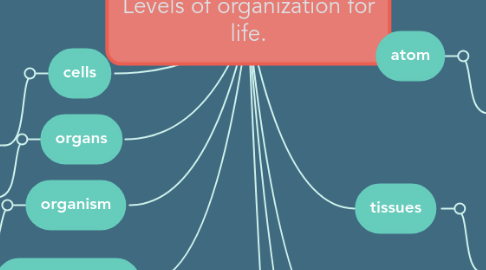Levels of organization for life.
by Sydney Freese

1. macromolecule
1.1. Proteins: Keep the Body Running. Proteins, like all macromolecules, form from smaller units that combine and connect together to form one larger molecule. Nucleic Acids: Blueprints for Life. Carbohydrates: Chemical Energy.
2. cells
2.1. All living things are made up of cells. Cells are made up of proteins and organelles. Groups of cells form tissues and systems. The main purpose of a cell is to organize. The longest cells in the human body are the motor neurons. Red blood cells carry oxygen around the body.
3. organs
3.1. Humans have five vital organs that are essential for survival. These are the brain, heart, kidneys, liver and lungs. The human brain is the body's control center, receiving and sending signals to other organs through the nervous system and through secreted hormones.
4. organism
4.1. They are called microorganisms. Organisms can be made up of just one cell. They are called unicellular organisms or single celled organisms. Examples include bacteria, and protozoa such as the Amoeba and Paramecium.
5. atom
5.1. There are three parts to an atom. Protons have a positive electrical charge and are found together with neutrons (no electrical charge) in the nucleus of each atom. Negatively charged electrons orbit the nucleus. Atoms are the smallest particles that make up elements.
6. molecule
6.1. Oxygen gas normally is the molecule O2, but it can also be O3 which we call ozone. 66% of the mass of the human body is made up of oxygen atoms. Molecules can have different shapes.
7. organelles
7.1. Organelle. An organelle is a specialized cellular structure in eukaryotic cells analogous to an organ in the body. Organelles are discrete structures within the cell that perform a specialized function. Most are surrounded by internal membranes and can be seen in the light or the electron microscope.
8. tissues
8.1. Human body tissue makes up organs and other body parts. There are four main types of tissue: muscle, epithelial, connective and nervous. Each is made of specialized cells that are grouped together according to structure and function. Muscle is found throughout the body and even includes organs such as the heart.
9. organ system
9.1. Circulatory System. (heart, blood, vessels) Respiratory System. (nose, trachea, lungs) Immune System. (many types of protein, cells, organs, tissues) Skeletal System. (bones) Excretory System. (lungs, large intestine, kidneys) Urinary System. Muscular System. Endocrine System.


